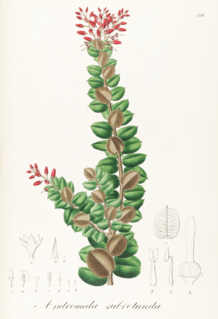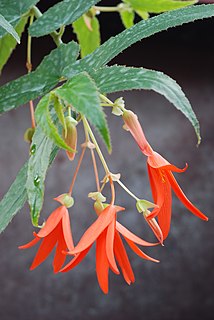
Phoneutria is a genus of spiders in the family Ctenidae. Phoneutria venom is potentially medically significant to humans. They are mainly found in northern South America, with one species in Central America. Members of the genus are commonly referred to as Brazilian wandering spiders. Other English names include armed spiders and banana spiders.

Iniidae is a family of river dolphins containing one living genus, Inia, and four extinct genera. The extant genus inhabits the river basins of South America, but the family formerly had a wider presence across the Atlantic Ocean.

Inia is a genus of river dolphins from South America containing one to four species.

Squirrel monkeys are New World monkeys of the genus Saimiri. Saimiri is the only genus in the subfamily Saimirinae. The name of the genus is of Tupi origin and was also used as an English name by early researchers.

The black-capped squirrel monkey is a species of New-World monkey native to the upper Amazon basin in Bolivia, western Brazil and eastern Peru. They weigh between 365 and 1135 grams and measure, from the head to the base of the tail, between 225 and 370mm. Black-capped squirrel monkeys are primarily tree-dwelling and are found in both native and plantation forests as well as some farmed areas near running water. Their diet is omnivorous and mostly consists of flowers, fruit, leaves, nuts, seeds, insects, arachnids, eggs and small vertebrates. They mostly live in female-dominated troops of around 40 to 75 monkeys, with males having been observed to disperse to live in all-male troops after reaching sexual maturation. Their current conservation status according to the IUCN is 'Least Concern'. The species belongs to the genus Saimiri and has two subspecies, S. b. boliviensis and S. b. peruviensis.
The Bolivian bamboo rat, is a species of spiny rat from South America.

Akodon spegazzinii, also known as Spegazzini's akodont or Spegazzini's grass mouse, is a rodent in the genus Akodon found in northwestern Argentina. It occurs in grassland and forest at 400 to 3,500 m above sea level. After the species was first named in 1897, several other names were given to various populations now included in A. spegazzinii. They are now all recognized as part of a single, widespread and variable species. Akodon spegazzinii is related to Akodon boliviensis and other members of the A. boliviensis species group. It reproduces year-round. Because it is widely distributed and common, Akodon spegazzinii is listed as "least concern" on the IUCN Red List.
The Bolivian tuco-tuco is a species of rodent in the family Ctenomyidae. It is found in Argentina, Bolivia, and Paraguay.

Agarista is a genus of plants in the family Ericaceae. Agarista species contain grayanotoxins, a group of closely related neurotoxins named after Leucothoe grayana, native to Japan.

Akodon caenosus is a rodent in the genus Akodon found in northwestern Argentina and south-central Bolivia. Since its description in 1918, it has been alternatively classified as a separate species or a subspecies of Akodon lutescens. The species Akodon aliquantulus, described from some very small Argentine specimens in 1999, is now recognized as a synonym of A. caenosus.

Begonia boliviensis is a plant in the begonia family, Begoniaceae, which was introduced to Europe in 1864 by Richard Pearce who discovered it in the Bolivian Andes, although the plant had previously been identified by Hugh Weddell in the same region but not introduced.

The Bolivian river dolphin is a species of the genus Inia.

Scaphyglottis boliviensis is a species of orchid found from Central America to tropical South America.

Eupalamides is a genus of moths within the family Castniidae. It was described by Constant Vincent Houlbert in 1918.
Eupalamides guyanensis is a moth in the Castniidae family. It is widely distributed in northern South America, from Venezuela to Guyana, Colombia and Brazil (Pará).
Eupalamides cyparissias is a moth in the Castniidae family. It is widespread in the Amazon basin including Peru, Colombia, Ecuador, Venezuela, Brazil, the Guianas, Suriname and north to Panama.
Eupalamides geron is a moth in the Castniidae family. It is found in Brazil.
Eupalamides preissi is a moth in the Castniidae family. It is found in Peru.
Eois boliviensis is a moth in the family Geometridae. It is found in Bolivia.
Galinsoga boliviensis is a rare Bolivian species of flowering plant in the family Asteraceae. It has been found in Oropeza Province in central Bolivia.











